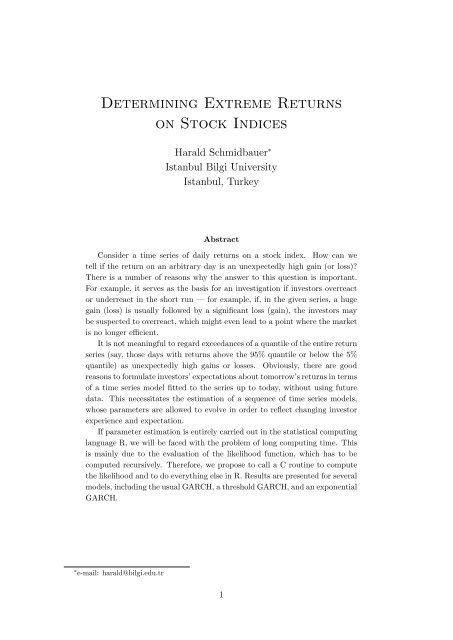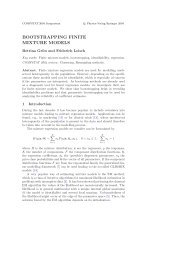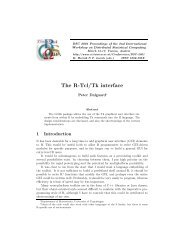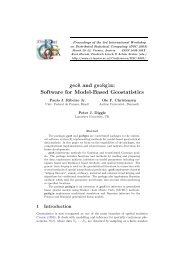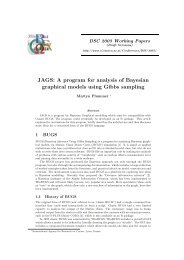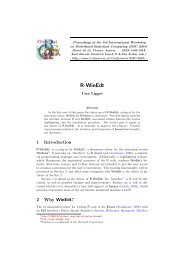Embedding R in Windows applications, and executing R remotely
Embedding R in Windows applications, and executing R remotely
Embedding R in Windows applications, and executing R remotely
Create successful ePaper yourself
Turn your PDF publications into a flip-book with our unique Google optimized e-Paper software.
Determ<strong>in</strong><strong>in</strong>g Extreme Returns<br />
on Stock Indices<br />
Harald Schmidbauer ∗<br />
Istanbul Bilgi University<br />
Istanbul, Turkey<br />
Abstract<br />
Consider a time series of daily returns on a stock <strong>in</strong>dex. How can we<br />
tell if the return on an arbitrary day is an unexpectedly high ga<strong>in</strong> (or loss)?<br />
There is a number of reasons why the answer to this question is important.<br />
For example, it serves as the basis for an <strong>in</strong>vestigation if <strong>in</strong>vestors overreact<br />
or underreact <strong>in</strong> the short run — for example, if, <strong>in</strong> the given series, a huge<br />
ga<strong>in</strong> (loss) is usually followed by a significant loss (ga<strong>in</strong>), the <strong>in</strong>vestors may<br />
be suspected to overreact, which might even lead to a po<strong>in</strong>t where the market<br />
is no longer efficient.<br />
It is not mean<strong>in</strong>gful to regard exceedances of a quantile of the entire return<br />
series (say, those days with returns above the 95% quantile or below the 5%<br />
quantile) as unexpectedly high ga<strong>in</strong>s or losses. Obviously, there are good<br />
reasons to formulate <strong>in</strong>vestors’ expectations about tomorrow’s returns <strong>in</strong> terms<br />
of a time series model fitted to the series up to today, without us<strong>in</strong>g future<br />
data. This necessitates the estimation of a sequence of time series models,<br />
whose parameters are allowed to evolve <strong>in</strong> order to reflect chang<strong>in</strong>g <strong>in</strong>vestor<br />
experience <strong>and</strong> expectation.<br />
If parameter estimation is entirely carried out <strong>in</strong> the statistical comput<strong>in</strong>g<br />
language R, we will be faced with the problem of long comput<strong>in</strong>g time. This<br />
is ma<strong>in</strong>ly due to the evaluation of the likelihood function, which has to be<br />
computed recursively. Therefore, we propose to call a C rout<strong>in</strong>e to compute<br />
the likelihood <strong>and</strong> to do everyth<strong>in</strong>g else <strong>in</strong> R. Results are presented for several<br />
models, <strong>in</strong>clud<strong>in</strong>g the usual GARCH, a threshold GARCH, <strong>and</strong> an exponential<br />
GARCH.<br />
∗ e-mail: harald@bilgi.edu.tr<br />
1


